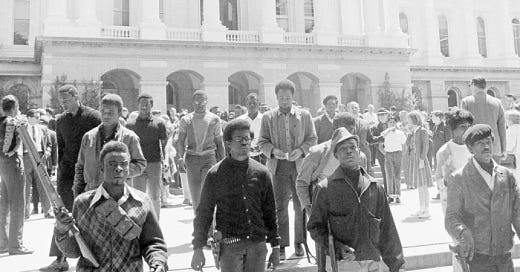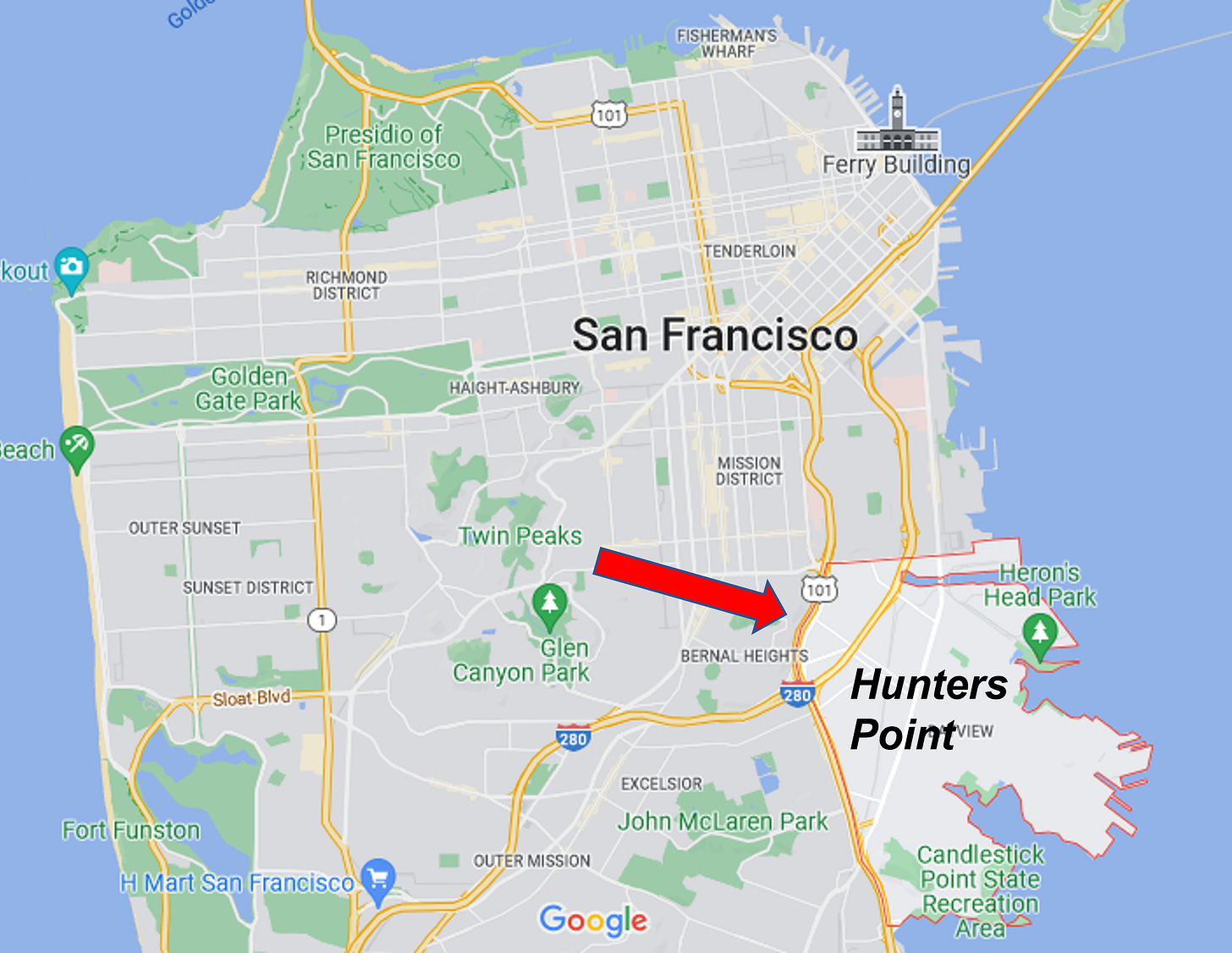Race in America: The Black Panther Party
Dissecting how African Americans organized politically after the Civil Rights Movement and how their embrace of the 2nd Amendment threatened the political establishment.
Topline Takeaways
Spurred by the Hunters Point Uprising and localized armed resistance movements in the South, Huey Newton established the Black Panther Party for Self Defense in the late 1960s.
The party was originally organized around its defense of open carry laws for the purpose of “copwatching:” monitoring police activity to defend communities against police brutality.
The party terrified White legislators, prompting several government actions including new gun control laws and the weaponization of the FBI against Black nationalists.
The Hunters Point Uprising
The Black Panther Party was established in the twilight years of the Civil Rights Movement, following the passage of the Civil Rights Act of 1964 and the assassination of Malcolm X in 1965. While African Americans across the South lauded recent racial justice progress, those living in cities along the coasts and in the North. Since Jim Crow laws were only prevalent in the South, many urban African Americans were growing skeptical of the relevancy of the Civil Rights Movement to their own lives as they faced more covert forms of discrimination and intolerance that went unaddressed.
The struggles of urban African Americans was put on full display in the Hunters Point Uprising of 1966. Hunters Point is a neighborhood on the southwestern edge of San Francisco that was once home to a sizable African American population. In the 1960s the neighborhood struggled with poverty, a lack of local jobs, and a dearth of basic services like grocery stores and hospitals. It was estimated that African Americans in the city had an unemployment rate three times that of their White counterparts.
On September 27, 1966, Matthew Johnson, a Black teenager, was pursued, shot and killed by police officers in the Hunters Point neighborhood as they suspected he had stolen a car. Less than a month later, a jury ruled the case a justifiable homicide and ordered the reinstatement of all officers involved. Naturally, the city’s African American community was angered by the series of events and quickly gathered to protest the ruling. The gatherings were classified as a riots by the SFPD leading to a curfew imposed only on the city’s African American neighborhoods. Advocacy groups immediately called out the ways the curfews “gerrymandered around all areas with a large Negro population.”

Unrest continued the following day across the city, prompting California to mobilize the National Guard, evoking parallels to the Watts riots that only happened a year prior. The unrest culminated at the Bayview Community Center: police officers unloaded bullets on the building for seven minutes as hundreds of children were stuck inside. (Remarkably, the uprising resulted in no additional deaths beyond Matthew Johnson.)
The LCFO: The Original Black Panther Party
Across the Bay in Oakland, Huey Newton watched the police response to the Hunters Point Uprising with disdain. Newton’s family moved to California from Louisiana to evade this exact type of racialized violence. He was originally born in Ouachita Parish, Louisiana; a county known for having one of the highest totals of documented lynchings across the country. The way this racism followed him out of the South pushed Newton toward action. While inspired by various Black Power organizations, Newton was particularly captivated by activists like Robert F. Williams and Stokely Carmichael who advocated for an organized, armed resistance to racialized violence.
The LCFO was formed initially as a voter registration project in Lowndes County, AL in 1965. At the time the county was 80% Black and had no registered Black voters. The LCFO founder, Stokely Carmichael, aimed to increase Black political participation and refused to support either of the major parties. He instead created a new local political party and chose a black panther as the party’s emblem. The party successfully signed up hundreds of Black voters and they were only able to do so through their commitment to armed resistance in the face of violent white supremacy.
Huey Newton’s Black Panther Party
After hearing a speech from Carmichael lauding the efficacy of armed resistance movements like the LCFO, Huey Newton and Bobby Seale co-founded the Black Panther Party for Self-Defense. They opened their first official headquarters in Oakland in January 1967. As mentioned in its name, the primary goal of the party in its early years was promoting self-defense within the Black community. They fiercely defended open carry laws for the purpose of “copwatching:” monitoring police activity to defend communities against police brutality.
In its first year of existence, the party quickly attracted both supporters and opponents. Due to its fiercely local approach, Black residents across the Bay area supported the Black Panther Party and regularly sought its help to deal with local cases of police brutality. The party was enlisted by the community to investigate the shooting of an unarmed Black man in April 1967 and even provided an armed escort to Betty Shabazz, Malcolm X’s widow. Meanwhile, the party’s fierce commitment to open carry laws also earned it a hostile and violent reputation from the perspective of White voters. Despite the party’s near-obsession with following gun laws as written, opponents were successfully able to paint the group as a violent organization.
After his first year running the party, Newton learned the importance of creating a more wide-reaching political agenda that extended beyond defending open carry laws. Seale and Newton worked together to develop “The 10-point Program” to serve as an agenda for the party and first published the list of demands in May 1967.
The 10-point Program
We want freedom. We want power to determine the destiny of our Black Community.
We want full employment for our people.
We want an end to the robbery by the Capitalists of our Black Community.
We want decent housing, fit for shelter of human beings.
We want education for our people that exposes the true nature of this decadent American society. We want education that teaches us our true history and our role in present-day society.
We want all Black men to be exempt from military service.
We want an immediate end to POLICE BRUTALITY and MURDER of Black people.
We want freedom for all Black men held in federal, state, county and city prisons and jails.
We want all Black people when brought to trial to be tried in court by a jury of their peer group or people from their Black Communities, as defined by the Constitution of the United States.
We want land, bread, housing, education, clothing, justice and peace.
When The NRA Supported Gun Control
White legislators across California (and the nation) were absolutely terrified by the imagery of armed Black protestors. Within months, California’s legislature whipped up the Mulford Act, a law that aimed to prohibit the public carrying of loaded firearms. The Act was drafted in direct opposition to the Black Panther Party. On May 2, the party made sure their voices were heard in government: 30 armed Black protesters occupied the California State Capitol building to highlight the racist motivations behind the bill.
The National Rifle Association watched their display in horror. The NRA forcefully backed the Mulford Act marking a rare moment when the group advocated for sweeping gun control measures. (Fun fact, the NRA also supported gun control measures when European immigrants were known for openly carrying firearms in the 1930s. Hope you notice the clear ethnic impulses guiding the NRAs agenda throughout history.)
FBI Drives A Wedge Into The Party
The Black Panther Party was covertly dismantled by the FBI’s Counter Intelligence Program (COINTELPRO). In August of 1967, the FBI was directed to “neutralize… black nationalist hate groups” while the organization’s chair pointed to the Black Panthers as the “greatest threat to the internal security of the country.” Rather than using force to end the group, the FBI deliberately created rivalries amongst their membership and inflamed existing tensions whenever possible. This came to a head in 1971 when Huey Newton faced off against other members in the group who held ideological differences. It resulted in retaliatory assassinations that left four dead while hundreds of supporters dissociated from the group due to its infighting. While The Black Panther Party attempted to rise from its ashes in a different form, they never reclaimed the popularity they garnered in the late 1960s.
Following the demise of the Black Panthers across the 1970s, those who had previously advocated for gun control policies magically changed their tune:
Reagan in 1975: “So isn’t it better for the people to own arms than to risk enslavement by power-hungry men or nations? The founding fathers thought so.”
This history is incredibly important to recount as only the most peaceful and sanitized views of civil disobedience are wrapped into the narrative of Black History Month. We do ourselves a disservice by turning a blind eye toward these more vitriolic moments of our history. When we advocate for equality, we’re advocating for an equal right to express our grievances in accordance with the law. That means we’re not only fighting for the right to protest peacefully, it means we’re also fighting for the right to hold a weapon and secure ourselves when the state fails to do so.




